Dynamic Component as Parametric Design Tool
-
@tig said:
Whilst I don't purport to compete with Rhino that last example image looks like something that EEbyRails could do...[attachment=0:3fx3px2g]<!-- ia0 -->Capture.PNG<!-- ia0 -->[/attachment:3fx3px2g]
Not the surface though. Basically, in my case, it's the application of shapes to said surface. In a roundabout way, grow mixed with extrude edges.
-
I've updated the examples...
-
I should note though that I wasn't using grasshopper which is more in tune with this topic.
I was using rhino's paneling tools. If you want a sweet ruby idea, download the paneling tools manual and check out some of the example functions.
(on a phone but I'll try to get a link)
Edit:
http://wiki.mcneel.com/_media/labs/panelingtoolsmanual.pdf.
-
@tig said:
I've updated the examples...
Maybe I posted the wrong example but I'm at an airport now so I can't do much about that. I'll put up a better example later.
But yeah, I know what extrude edges can do and it can't do this. -
@unknownuser said:
@tig said:
I've updated the examples...
Maybe I posted the wrong example but I'm at an airport now so I can't do much about that. I'll put up a better example later.
But yeah, I know what extrude edges can do and it can't do this.So... what is it trying to do that's 'different' ???
-
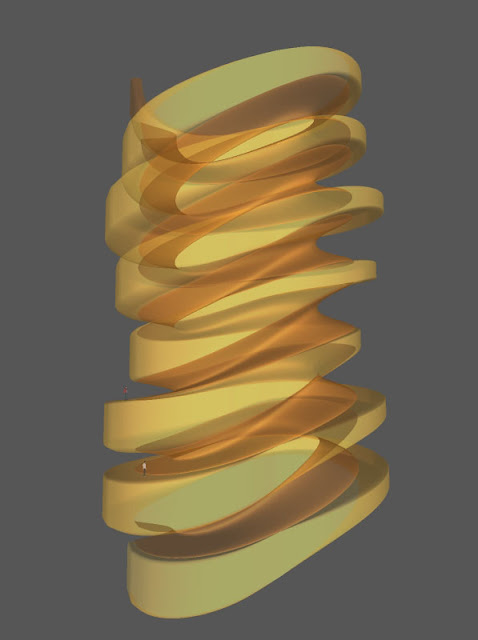
Hi guys.
I hope you guys didn't wait too much for my next result of DC experiments. Hopefully, I did something else during this weekend.
Hopefully, I did something else during this weekend.
After making several models and patterns only consisted of bricks, blocks or sticks etc, NOT of surfaces, I became very wonder how to make surfaces with DC formulas. And I want to do more things in parametric way with DC. Can it be done?
Fortunately during this weekend experiments, I think, I found out a solutin to make surfaces to the models which is totally conceived by DC formulas. And it looks very parametric to me.I should be honest to tell that, as you know, making surface is not possible within DC, cause it doesn't support any drawing tools!! Actually I usedFredo6's CurviloftRuby plugin to make surface from the set of sectional profiles which were transformed by DC formulas. Curviloft plugin, especially in this case, the 'loft by splines' looks wonderful solution. And the way doing with this plugin is also looks very parametric.
Let's check it out.See this screen shot.
This tells how I did above transforming spiral thing.
All I drew for model were two sectional profiles, and everything else was done by DC and 'loft by splines'.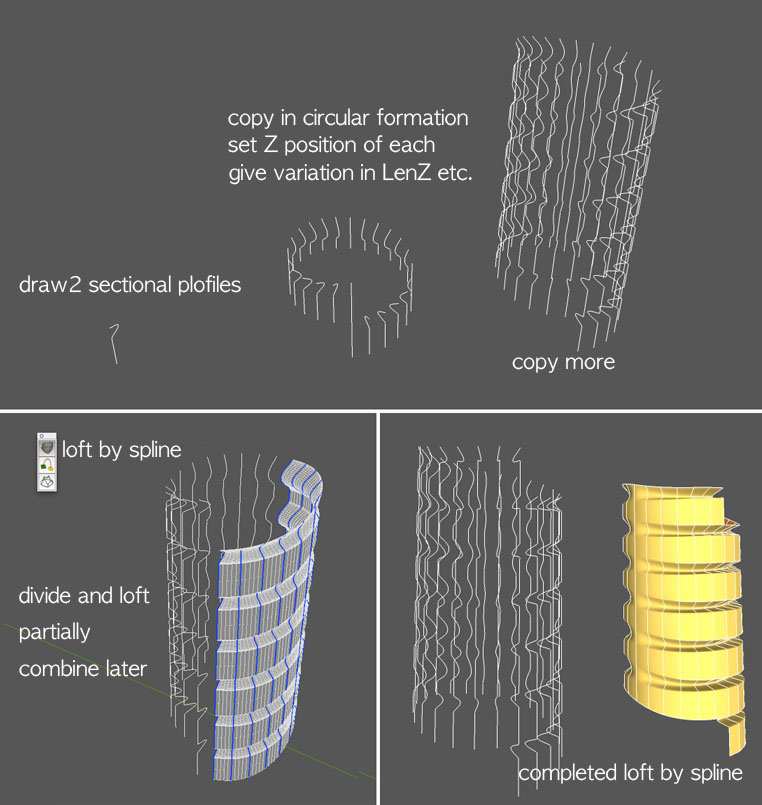
Cause it occurred crashes or unexpected results to loft with circular formation of splines, I did loft separately and combined later.
How do you guys think doing thing in this way?
I attached more images of 3 different variation from single DC model.
I changed several attributes of original DC formulas and it resulted in these 3 models.
There could be more variations depending on the change of attributes, say parameters, and I think this is parametric process of designing! (Actually I have already done more transformations)All three are spiral things.
They vary in volumes of spirals, depth of concave,etc. You can even change the radius of spiral circles, the height of floor, degree of variation of volume, and even more.Look, 3 different types of variation.

- type one with shallow but changing depth of concave.

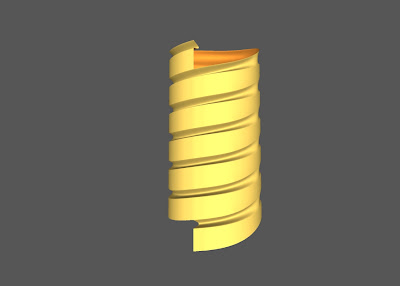
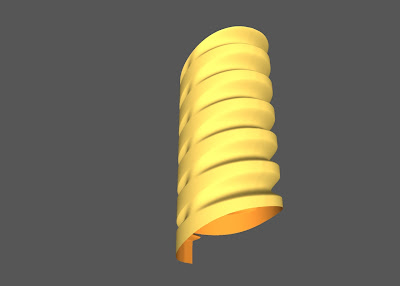
- type two with deeper and not changing concave.
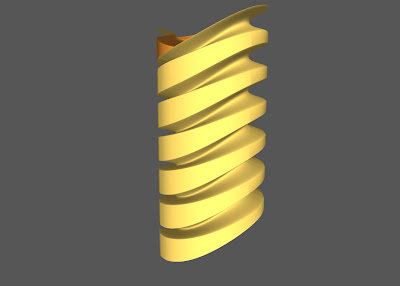
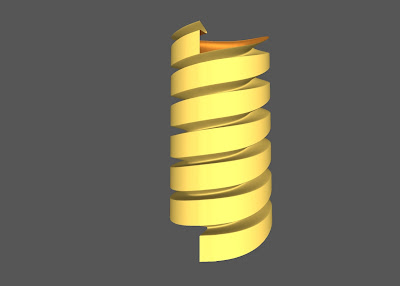
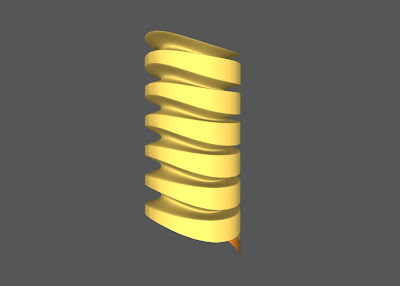
Also see http://taekle.blogspot.com/2010/09/dynamic-component-ruby-plugin4.html
- type 3
This has chaging volume along with spiral.
You can see original a set of copied and transformed profiles by DC, beside lofted surface, and Nancy & Sang.
I wonder any plugins of SU can make like this.
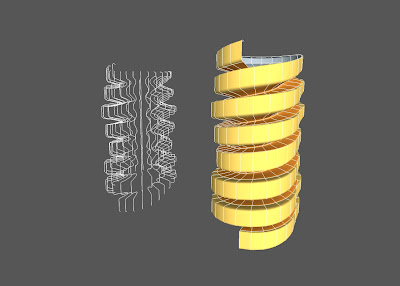
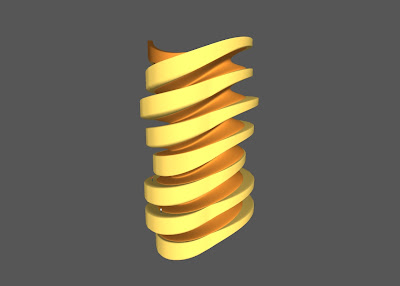
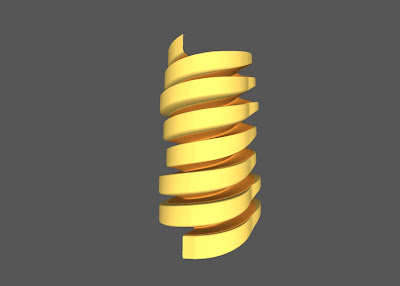
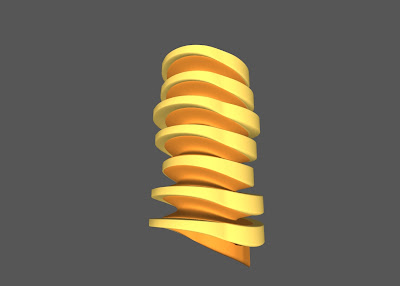

Also see http://taekle.blogspot.com/2010/09/dynamic-component-model-sketchup.html
Attached file below shows the formulas used in here. I am not sure you guys would be interested in such mathematics. But this makes all these things happen.
And below it is attribute option window. you can see changeable parameters beside a set of transformed profiles, and another variation of model.I did these things only on Sketchup, not Rhino, Max, or others.
More encouraging thing is that the possibilities of Sketchup is not over yet.Enjoy the power of SU with DC.
For more information and larger images visit my blog.

http://taekle.blogspot.com/


-
Taekle, I love what you have started here (soundtrack: standing ovations)
please continue fascinating us.Thank you for posting the screenshots, it does not look too difficult to learn DC. I for one don't feel afraid of the learning curve in SU. Although it will take some time to get into it.
As Edson says:"I have always thought DCs have great potential. the problem with them seems to be the need to understand all those formulae. I am sure it would be put to more uses if we were able to understand how it works."
why not have a workshop of some sort?
TIG, that 'EEbyRailsByFace' is a nice one!
Jeff, no question Rhino and Grasshopper have superior parametric modelling. But I am more looking at the effect that by showing examples you keep pushing us SketchUp folks here and I like that. (Quite often I heard "No way you modeled and rendered all this within SketchUp")
By the way: do you still remember Blend plugin?
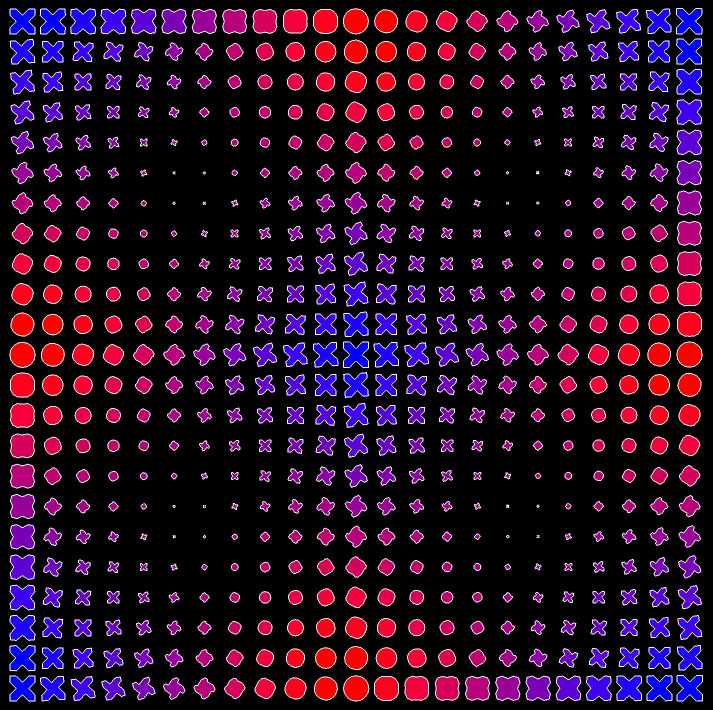
-
@unknownuser said:
you should be able to take some of your DC examples and fairly easily begin applying them to a physical item (if you so choose).. it'd be great if some of these patterns you've created could easily be applied to a surface for instance..
it'd be sweet if you could somehow incorporate the DC parametrics with ruby scripts to give something of a user interface instead of using the DC dialog. that dialog is just plain confusing to most people and not encouraging at all for most people to begin to learn it.
until something like a front end UI for su parametrics occurs, i think it will be limited to very few people but please, continue posting your experiments etc.. they're very interesting.
I agree with your opinion, it seems that DC totally can not compete with Rhino or others till now. I'm only exploring the unknown possibilities of DC, as you might know, in the hope of having better DC environment and UI, etc...
And Unfortunately, is there no way I can use Ruby with DC? If any, I only have beginner's idea about Ruby scripts yet.
And as you asked me to continue, I did one.
Looks not exactly same, but not totally impossible, either....
And I'm not even sure this is what you meant exactly.I used here what I had posted first on this topic, waved brick wall and circle attractor thing with modification of several parameters in size or numbers of copies, etc. Then superposed together and intersected each other.( I could have made the shape of holes as rectangle like your image, but left as it was in its original model. Only because I thought it would look nicer.)
Yes, as you may think, this might not be a quick method. But I wanted to do and did it any way




-
Taekle, excellent examples...I too am intimidated by the math involved, but am now more interested in learning after seeing what you've done here.
@shura said:
why not have a workshop of some sort?
+1

-
Hi mates,I'm also the one who concerns parametric design too
 .Thanks taekle for your very usefull tips.
.Thanks taekle for your very usefull tips.
I'm new to Dynamic Component,this my very first try.
-
Can't say I'm doing anything as exciting as this - but for a bit I was playing with generating timbers and joinery, and also generating tools for compound roof design. Because I need to have the volume of the timber untouched (and in one component) - I'm not modeling the backing cuts or end cuts - but creating guidelines over the volume, and then using marker components to swap out for joinery, that are also dynamic. The wireframe house shape in the beginning of the video is also a dyn component - I can change plate height, pitch(es), etc. I use this when creating gable shapes, then I lock it and use it as a guide for my framing.
This was very preliminary... and used as a proof of concept. If I ever have time I'd get back in and refine these things (or learn Ruby...)
-
@cucsat2003 said:
I'm new to Dynamic Component,this my very first try.
Cucsat2003! You are the first and still only one who uploaded a DC parametric model except me!

Please keep posting your results.Shura, I feel happy that my screenshots were helpful to you.
And the result of 'blend plugin' looks fantastic! It inspires me very much! Thanks.D12dozr, I hope you still keep interesting DC parametric things.
I will post with another DC model(s) ASAP.Please keep concerning everybody!
By the way, how can the workshop be done?
-
 That's awesome, taekle!
That's awesome, taekle! 
Thanks for the detailed explanation, I'm going to go back and read it half a dozen times or so, so that it can soak in... -

Hi guys, As I said before I've come back with another 2 DC parametric models.
They are very simple comparing with the ones I posted before.
And I am conceiving something different in DC parametric model, I'll also introduce that here someday.Then enjoy DC parametric world again.




As you see the formula is very simple.
After 'loft by splines' of this set of profiles(I only drew a half circle), then copy 3X3. That's it!.
Try this yourself.I'll give some explanation of the key parts(or steps) of this formula.
- Draw a half circle in any size along with (in this case) red axis('X' axis).
Arc or any other profiles will be also alright. Then make component, in this case 'half_cir' - Set formula to copy in X axis.('s' attribute is set for spacing between these copies.)
- Select these copies and make component, in this case 'set_cir_X'(parent of 'half_cir')
and again set formula to copy in green axis('Y' axis). - In LenZ of 'half_cir', type any formula you want. I like to use 'sin' and 'cos', cause they are periodic.
In this formula you should include 'X' or 'copy' of its own and 'Y' coordinate of 'set_cir_X'(parent).
'Y' coordinate of parent component will make sub-component changing along with 'Y' axis. - In RotX of 'half_cir', type '=if(copy=odd(copy),180,0)'. This will make every two half circles upside down which then looks like wave or pulse.
- After complete every step then copy and move to other place, and explode every component included.
- Do 'loft by splines'
Next one also has regular pattern but a little bit deformed.

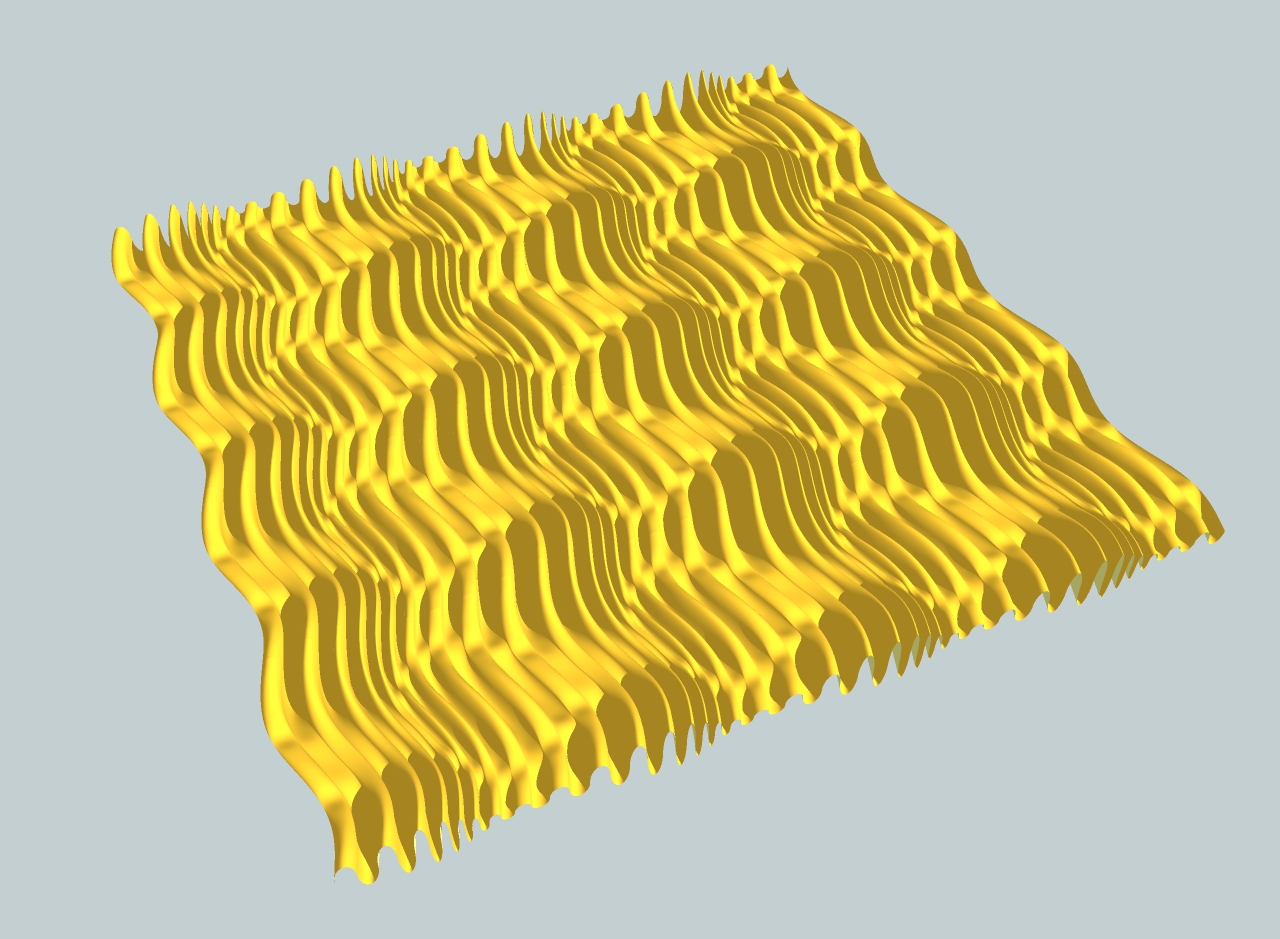



There are two differences to first one.
In this case you should set the 'PosX' of 'half_cir' in formula.
Then set 'LenX' accordance with PosX.
I mean [Nth** LenX] = [(N+1)th PosX] - [Nth PosX]**.
The formula expressed in LenX of 'half_cir' means this.(here 'copy' roles 'N')
Little bit more complex but not that difficult.You can see below a set of profiles, lofted surface and result of 3X3 copy of that.(resulted in 4X4)

Any one who feels interesting in DC parametric process please try yourself and post your own results here!
I uploaded first one's SKU file on my blog. Visit my blog and find your way.

http://taekle.blogspot.com/2010/11/regular-but-deformed-surface-using.html - Draw a half circle in any size along with (in this case) red axis('X' axis).
-
nice taekle


out of curiosity, will you post a hidden line view of the waves and maybe the model stats (face count, # of edges, etc) ?
thanks[edit] ha, nevermind
 i can get it from your blog i see.
i can get it from your blog i see.[edit-2] actually, i can't get if from your blog. when i click the link, i get this:
*%(#FF0000)[Sorry, the page (or document) you have requested is not available.
Please check the address and try again.]*
-
@unknownuser said:
[edit-2] actually, i can't get if from your blog. when i click the link, i get this:
*%(#FF0000)[Sorry, the page (or document) you have requested is not available.
Please check the address and try again.]*
Jeff Hammond, sorry, I fixed link on my blog, please try again.
(In Google doc's, sometimes, this kind of link error occurs.
They used to say the error is related to multi-login information or something like that)If you still have problem then let me know.
taekle.
-
I just visualized the movement of a simple DC parametric model.
Enjoy this video.[flash=640,505:20olptmb]http://www.youtube.com/v/gzAISi4ZXWA?fs=1&hl=en_GB[/flash:20olptmb]
[flash=640,505:20olptmb]http://www.youtube.com/v/RFbvBJvA8Hk?fs=1&hl=en_GB[/flash:20olptmb] -
Back again, and again holding my breath. I wonder if I ever get my head around DCs.
(did not loose interest, just moved to new appartment and waiting much too long for the internet connection )
)
That last visualization is really great, and thaks for sharing the waves pattern. -
Completly missed this thread! Very cool examples!

Advertisement







